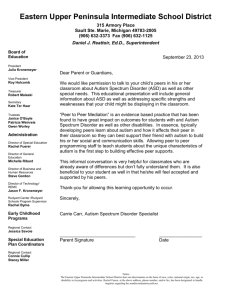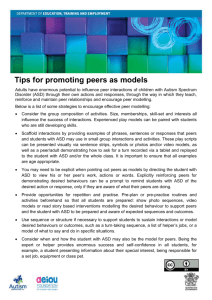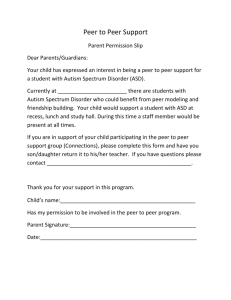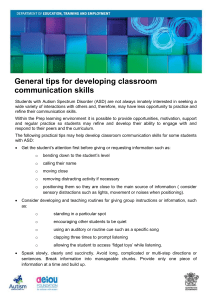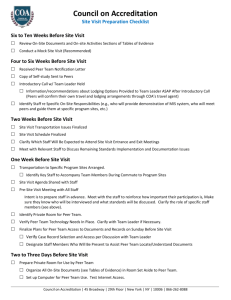Peer Mediated Instruction and Intervention (PMII)
advertisement
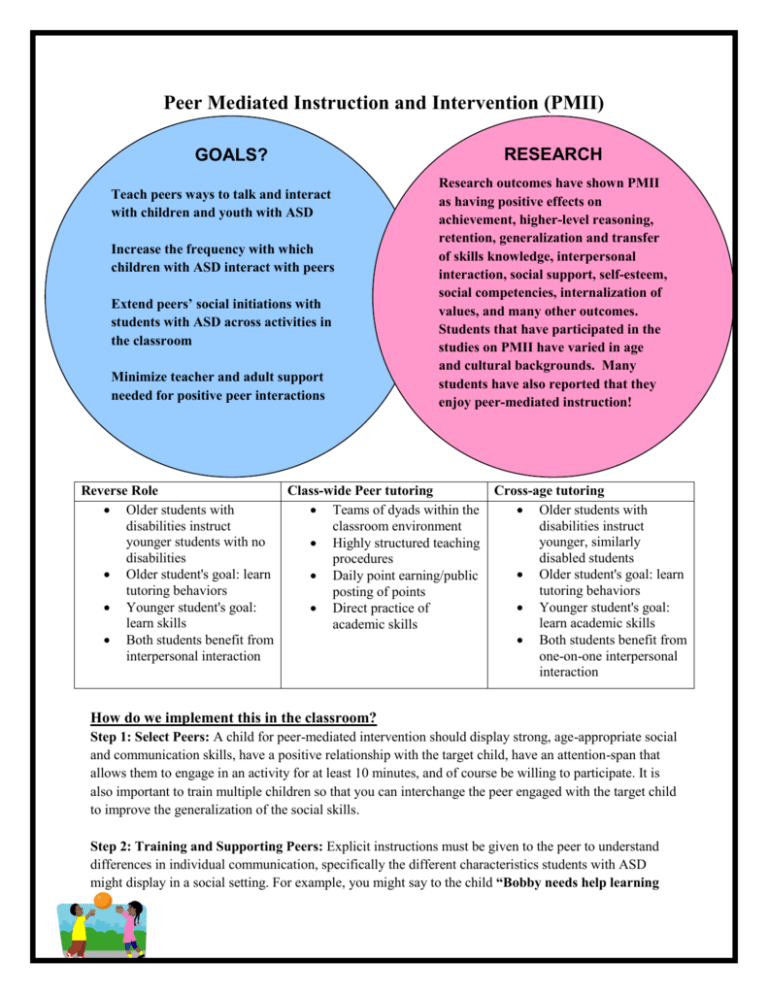
Peer Mediated Instruction and Intervention (PMII) RESEARCH GOALS? Teach peers ways to talk and interact with children and youth with ASD Increase the frequency with which children with ASD interact with peers Extend peers’ social initiations with students with ASD across activities in the classroom Minimize teacher and adult support needed for positive peer interactions Research outcomes have shown PMII as having positive effects on achievement, higher-level reasoning, retention, generalization and transfer of skills knowledge, interpersonal interaction, social support, self-esteem, social competencies, internalization of values, and many other outcomes. Students that have participated in the studies on PMII have varied in age and cultural backgrounds. Many students have also reported that they enjoy peer-mediated instruction! Reverse Role Class-wide Peer tutoring Older students with Teams of dyads within the disabilities instruct classroom environment younger students with no Highly structured teaching disabilities procedures Older student's goal: learn Daily point earning/public tutoring behaviors posting of points Younger student's goal: Direct practice of learn skills academic skills Both students benefit from interpersonal interaction Cross-age tutoring Older students with disabilities instruct younger, similarly disabled students Older student's goal: learn tutoring behaviors Younger student's goal: learn academic skills Both students benefit from one-on-one interpersonal interaction How do we implement this in the classroom? Step 1: Select Peers: A child for peer-mediated intervention should display strong, age-appropriate social and communication skills, have a positive relationship with the target child, have an attention-span that allows them to engage in an activity for at least 10 minutes, and of course be willing to participate. It is also important to train multiple children so that you can interchange the peer engaged with the target child to improve the generalization of the social skills. Step 2: Training and Supporting Peers: Explicit instructions must be given to the peer to understand differences in individual communication, specifically the different characteristics students with ASD might display in a social setting. For example, you might say to the child “Bobby needs help learning how to play with blocks appropriately. Can you help me?” Then provide the child with specific comments to say to initiate interactions (e.g. “Toss me the ball”) with the target child and specific feedback responses they can give to the peer when playing appropriately and inappropriately (e.g. “Great job!” or “I need help with ____.”) Step 3: Implementing a Structured Teaching Section: Teacher should facilitate structured play sessions that occur daily for 5-8 minutes. The teacher should introduce the play activity, provide prompts to the peer and give positive reinforcement as necessary. Once the peer has mastered the social skill techniques, the teacher slowly takes away prompting and reinforcement. If there is no interaction after 30 seconds between peer and child with ASD, the teacher should provide a prompt, such as modeling an appropriate action or response with the peer, or regaining the target child’s attention. Step 4: Implementation Considerations: Peer activity should take place at the same time each day and it should be in an area free from other distractions. Toys for play should have a theme and preferably a game that requires assistance in operating (e.g. puzzles, board games). ** Steps adapted from Sperry, Neitzel & Engelhardt-Wells, 2010 article titled “Peer-Mediated Instruction and Intervention Strategies for students with Autism Spectrum Disorder”. What Does this Look Like? Example scenario: Ben is a 9-year-old boy with autism who is good at drawing and arts and crafts but experiences challenges with social interactions. Ben prefers to work alone and does not like to participate in group activities. In order to assist him in acquiring social skills that will help him participate in class discussions, Ben’s teacher decided to use peer-mediated instruction. She asked Jack, a classmate who also enjoyed art, to be Ben’s peer buddy during art class (Step 1). The teacher explained to Jack that her goal was to have Ben communicate with others during art class. Specifically, she wanted Ben to ask other members about their art projects and show the group his project in return. Jack agreed to be Ben’s peer buddy, and their teacher taught him how to model and prompt conversation (Step 2). Jack sat by Ben during art class each day, modeling the initiation skills and encouraging Ben to express his thoughts. They had 5 minutes at the end of class to talk to one another and play Pictionary. At first, the teacher provided Jack and Ben with specific prompts and monitored frequently; however, as the intervention continued the teacher involvement faded (Step 3). This activity took place in the back of the room in the “creativity corner” (Step 4). With assistance from Jack, Ben began to talk with others during art class. The other group members recognized Ben’s talent and were happy that he was in their group. Generalization Generally, children with ASD have a hard time generalizing skills to various settings, which is why it is so important that skills are taught in the most naturalistic situation. It also helps incorporate flexibility in their understanding of the concept (Sperry et al., 2010). To increase generalization of the skill, it is important to reinforce the use of the skills in various naturalistic settings (e.g. playground, house, school, play dates). It is also important that you train multiple peers and encourage the child to interact with other peers as much as possible. Given that children with autism often think the rules only apply to the context they learned it in, it is also important that you change up the type of play (e.g. board, game, imaginative play, tossing ball) in which you reinforce their social skill interactions. Facilitation from the teacher may be necessary during impromptu situations. It is important that you find a peer at the same developmental age range so that they can practice and have age-appropriate social skill reinforced. Resources Hall, T. and Stegila, A. National Center of Accessible Instructional Materials. (2009). “Peer Mediated Instruction and Intervention.” Retrieved from http://aim.cast.org/learn/historyarchive/backgroundpapers/peermediated_instruction McIntyre, T. (2003). Teaching Social Skills to Kids Who Don’t Have Them Yet. Retrieved on March 20, 2011 from http://www.ldonline.org/article/Teaching_Social_Skills_to_Kids_Who_Don%27t_Yet_Have_Them. Sperry, L., Neitzel, J., & Englehardt-Wells, K. (2010). Peer-Mediated Instruction and Intervention Strategies for Students with Autism Spectrum Disorders. Preventing School Failure, 54(4), 256-264. Peer or Sibling Mediated Instruction and Intervention What are the goals of Sibling Mediated Instruction and Intervention? 1. Teach siblings or peers ways to talk and interact with children and youth with ASD 2. Increase the frequency with which children and youth with ASD interact with siblings 3. Extend peers’ social initiations with students with ASD across activities in the classroom 4. Minimize teachers’ and adults’ support needed for peer interaction 5. Promote interactions between typically developing peers and siblings with ASD that are positive and natural in quality. (258) Research outcomes have shown PMII as having positive effects on achievement, higher-level reasoning, retention, on-task behavior, generalization and transfer of skills knowledge, social and cognitive development, interpersonal interaction, social support, self-esteem, social competencies, internalization of values, and many other outcomes. How do we implement this at home? Step 1: Select Siblings or Peers: A child or sibling participating in a peer mediated intervention should display strong, age-appropriate social and communication skills, have a positive relationship with the target child, have an attention-span that allows them to engage in an activity for at least 10 minutes, and of course be willing to participate. It is also important to train multiple children so that you can interchange the peer engaged with the target child to improve the generalization of the social skills. Step 2: Training and Supporting Peers or Siblings: Explicit instructions must be given to the sibling or peer to understand differences in individual communication, specifically the different characteristics students with ASD might display in a social setting. For example, you might say to the child “Bobby needs help learning how to play with blocks appropriately. Can you help me?” Then provide the child with specific comments to say to initiate interactions (e.g. “Toss me the ball.”) with the target child and specific feedback responses they can give to the peer when playing appropriately and inappropriately (e.g. “Great job!” or “I need help with ____.”) Step 3: Implementing a Structured Teaching Section: Family should facilitate structured play sessions that occur daily for 5-8 minutes. The model sibling or peer should introduce the play activity, provide prompts to the sibling with ASD and give positive reinforcement as necessary. Once the sibling or peer has mastered the social skill techniques, the family slowly takes away prompting and reinforcement. If there is no interaction after 30 seconds between sibling or peer and child with ASD, the parent should provide a prompt, such as modeling an appropriate action or response with the peer, or regaining the target child’s attention. Step 4: Implementation Considerations: The peer or sibling activity should take place at the same time each day and it should be in an area free from other distractions. Toys for play should have a theme and preferably a game that requires assistance in operating (e.g. puzzles, board games). ** Steps adapted from Sperry, Neitzel & Engelhardt-Wells, 2010 article titled “PeerMediated Instruction and Intervention Strategies for students with Autism Spectrum Disorder”. What Does This Look Like? Bobby and Steve are brothers, separated by three years. Steve has a growing awareness of his younger brother’s tendency to grab toys and games, listen without responding to questions in family conversations, and playing alone when he found an activity he preferred. Because the two had a good relationship and worked well together, the boys’ parents decided to try Sibling Mediated Instruction and Intervention (Step 1). In order to help Bobby with these social interactions, the children’s parents suggested that Steve model conversation and demonstrate appropriate ways to initiate and respond. They offered support to Steve to enforce how much they respected him as a leader, and encouraged him throughout the week-long sibling mentor time period (Step 2). Each evening, the family devoted 20 minutes between dinner and bath time for the boys to play a game of their choice, and most evenings, Connect 4 was the selection. Steve modeled asking for help with questions like, “Can you help me?” and making positive comments like “I like your choice!” In response, he helped coach Bobby with responses like “Ok, I can help you,” and “Thanks! You made a good move too!” (Step 3). The parents noticed that the conversation flowed more smoothly after a few evenings’ practice. Because Bobby had a great deal of respect for Steve, he was motivated to follow Steve’s lead, help with the game, and answer his questions. The strategy worked so well that the parents decided to help Bobby use his new skills in a variety of settings. Over the following weeks and months, the consistent practice helped both boys improve their social skills, and Bobby’s kindergarten teacher commented that he applied his skills even to school! Generalization Generally, children with ASD have a hard time generalizing skills to various settings, which is why it is so important that skills are taught in the most naturalistic situation. It also helps incorporate flexibility in their understanding of the concept (Sperry et al., 2010). To increase generalization of the skill, it is important to reinforce the use of the skills in various naturalistic setting (e.g. playground, house, school, play dates). It is also important that you train multiple peers and encourage the child to interact with other peers as much as possible. Given that children with Autism often think the rules only apply to the context they learned it in, it is also important that you change up the type of play (e.g. board, game, imaginative play, tossing ball) in which you reinforce their social skill interactions. Facilitation from the parent may be necessary during impromptu situations. If the sibling is distinctly older or younger than the child with Autism it is important that you find a peer at the same developmental age range so that they can practice and have reinforcement for age-appropriate social skill. References: Bass, J. D., & Mulick, J. A. (2007). Social Play Skill Enhancement of Children with Autism Using Peers and Siblings as Therapists. Psychology in the Schools, 44(7), 727-735. Brown, A. (March 20, 2011). Teaching young children social, emotional skills. The Morning Sun. http://www.morningsun.net/lifestyles/columns/x698062127/Teaching-young-children-social-emotionalskills Sperry, L., Neitzel, J., & Englehardt-Wells, K. (2010). Peer-Mediated Instruction and Intervention Strategies for Students with Autism Spectrum Disorders. Preventing School Failure, 54(4), 256-264.
